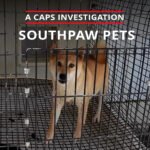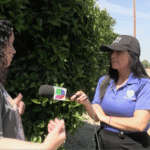Breeder: Taylor, Robert
Address: 700 Clark St.
City, State Zip: Canton, MO 63435
Year: 2012
USDA License: 43-A-4664 cancelled in 2011
Date of CAPS Investigation: 2012-06-30
On the premises at the time of investigation: Approximately 200+ dogs.
Breeds: Yorkshire Terriers, Italian Greyhounds, Shiba Inus, Maltese, Bichon Frise, Poodles, Shih Tzus, Siberian Huskies, Jack Russell Terriers, Beagles, more.
The temperature at the time of the investigation was 85 degrees Fahrenheit and sunny.
Building Type #1:
I arrived at Robert Taylor’s kennel around 1 pm. No one was present at the kennel. I obtained his home phone number from a neighbor and then drove about 5 miles to his home, which is located separately, and then he drove me back to the kennels.
During the extent of my visit, Mr. Taylor fed and left water for several dogs haphazardly, indicating there was no food or water readily available for those dogs for an unknown amount of time and likely no set feeding schedule. Water must be readily available for dogs if not continually, often enough to ensure their health in the current weather conditions. On an 85 degree day, dehydration is common and water should be made available continuously (3.10 Watering). Also, according to Missouri State regulations, as of 2011, water must be provided continuously. At one point, Mr. Taylor filled a water bowl belonging to a group of Beagles with the contents of an old bleach container. The contents in this container were unknown and would not be considered a potable origin of water or an acceptable container (3.10 Watering).
There were four rows of wire kennels stacked two high, the lower one being about 4 feet off the ground. There were also three rows of kennels of the same structure, but only one kennel high. The kennels were very old and did not seem structurally sound, as the structure appeared to be leaning (3.1(a) Housing facilities, general) (3.6(a)(1) Primary Enclosures) (3.6(a)(2)(v) & (vi) Primary Enclosures). They were made of plastic PVC piping for the supports and metal caging for the walls and floors. The metal caging was rusted in many locations (3.1(c)(i) Housing facilities, general). The caging on the floors had cracks about 3/4” thick between each bar, the cracks too wide for a dog to stand comfortably. Many of the dogs had very long, unkempt toenails which can lead to kennel foot and very painful injuries.
The kennels did not have any visible bedding, and temperatures in this area drop below 50 degree Fahrenheit in the winter (3.2(a)-Indoor housing facility) (3.4(b)(4) Outdoor housing Facility). No air conditioning seemed to be provided for the inside portions of the kennels as it was the same temperature inside the kennels as outside (3.1(d)-Housing facilities, general) (3.2(a) & (c)-Indoor housing facilities) (3.3(a) & (c)-Sheltered housing facilities).
At one point, Mr. Taylor picked up a very small puppy, likely under 1 week of age, and handled it carelessly. Puppies this small should not be handled, as it causes stress and potential injury to both the puppy and the mother (2.131(b)(1) Miscellaneous). Many dogs were seen with overgrown toenails, and matted fur. Overgrown toenails can become caught and break and/or become painful, and matting can lead to various skin issues. This is a vet care violation. If a licensed veterinarian does not conduct daily observations, a mechanism of direct and frequent communication is required so that timely and accurate information on problems of animal health, behavior, and well-being are being conveyed to the attending veterinarian (2.40(a) Attending veterinary and adequate veterinary care) (2.40(b)(2) & (3) Attending veterinary and adequate veterinary care)
Building Type #2:
The large breed dogs were kept in grounded pens separate from the other dogs and had no access to indoor housing (3.4(b) Outdoor Housing Facility). Siberian Huskies are dogs not acclimated to this temperature range because they originate from a much colder climate and should be restricted from being kept in outdoor housing facilities that are cooled (3.4(a)(1)(i) & (ii) Outdoor housing facilities). The dogs were not shaved and had full coats further exacerbating the heat. The facilities for larger dogs did not have roofs to help provide shade (3.4(b) Outdoor housing facilities) (3.4(b)(1) & (2) Outdoor housing facilities). No bedding was provided for these dogs. (3.4(b)(4) Outdoor housing facilities).




